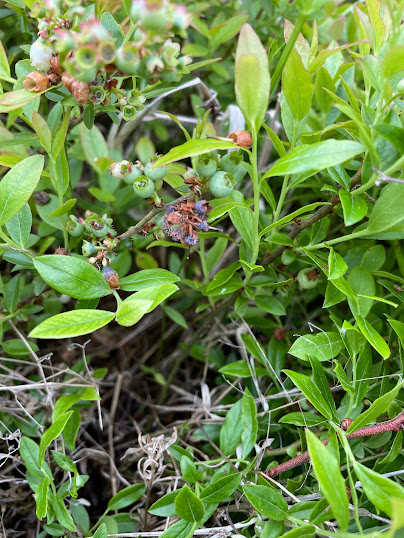Hello,
Things start to slow down in the wild blueberry world as
most of you already removed or planning to remove beehives from fields. Here
are a couple of reminders to help you to plan your trips and things you can
work on in the next few weeks before getting busy with harvesting again.
Events
1. WBPANS/
NSFA Field Session: Thursday, July 13 @ Kirkhill (near Parrsboro), NS
WBPANS
and NSFA are hosting a field session on July 13th on Kirkhill near
Parrsboro.
It is an afternoon session
from 2-3
pm
This field site is a part
of a larger Living Labs project, being administered by NSFA, that looks at ways
to sequester more carbon in our soils.
This wild blueberry field
site is looking at novel ways to establish shelterbelts that can act as a
carbon sink but also provide other ecological benefits for the environment and
production. Wind protection, snow retention and native pollinator habitat
are all integrated in the design.
This is a 5 year project
that will monitor benefits of the design and will allow growers to see the
impacts first hand. This site was just established this year, but study
leads will be there to describe the project and go over goals and answer
questions.
2. WBPANS
2023 Field Day: Tuesday, July 18 @ Queens County Exhibition Grounds, Caledonia,
NS.
Please register online before June
30! https://nswildblueberries.com/registration-form/
3. Nova
Scotia Power NS-NB Reliability Intertie
Wild blueberry growers may be interested in attending one
of the upcoming open house sessions with Nova Scotia Power to discuss a
potential upcoming project in your area and learn more about the NS-NB
Reliability Intertie. This project includes a second transmission line twinning
the current line to help provide reliable service, support the development of
renewable energy in our province, and facilitate the export and import of clean
energy.
To learn more, join them at one of the following
locations:
Wednesday, July 5th - 2-8 pm Royal
Canadian Legion, 74 Jackson Street, Oxford, NS
Thursday, July 6th, 2-8pm Business
Innovation Centre, 5 Ratchford Street, Amherst, NS
Wednesday, July 12th, 2-8 pm,
Wentworth Recreation Centre, 13572 Highway 4, Wentworth, NS
Thursday, July 13th, 2-8 pm,
Lower Onslow Community Centre, 12391 Highway 2, Lower Onslow, NS.
NS Power Open House Invitation
Programs and Funding Opportunities
1. Applications
Open for Emergency Relief Grant for Individuals- Wildfires
Nova Scotians who lost income
because of the recent wildfires in Halifax Regional Municipality and Shelburne
County may be eligible for short-term financial support through the Emergency
Relief Grant for Individuals.
Employed and self-employed Nova
Scotians who are not receiving Employment Insurance (EI) and those who had or
are in an EI waiting period may qualify for this relief grant. The amount of
the short-term emergency grant, either $275 or $550 per week, depends on the
extent of the impact faced.
To be eligible, workers must not
have been able to attend work, resulting in an interruption in income. They
must either live or work in a mandatory wildfire evacuation area or were
affected by business disruptions that happened because of the recent wildfires.
People who are self-employed and unable to operate their business, permanently
or temporarily, because of the wildfires may also qualify. Nova Scotia
volunteer firefighters who helped fight the Barrington Lake complex or
Tantallon wildfires, including Farmers Dairy Lane, and could not access paid
voluntary leave from their employers may also be eligible.
Information on how to access the
grant and eligibility is at: https://novascotia.ca/programs/emergency-relief-grant-individuals.
People with questions about the grant or application can contact an Employment
Nova Scotia office at 1-877-223-0888.
2. NSDA
SCAP Programs- application deadline: Friday, June 30, 2023
The deadline
for the Value Adding Equipment Program is this Friday, June
30, 2023. If you are considering a project and have any questions regarding
the program, please reach out to your Business Development Officer (BDO) or Ag.
Rep. to assist you with this program. The program application and guidelines
can be found at Value-Adding Equipment Program.
The Agricultural
Skills Student Bursary Program introduces agriculture to students as a
career option and helps address the labour gap for agriculture producers in
Nova Scotia. The program allows for students to develop business skills and
learn about value-adding processes by working on registered farms. Let your
summer students know about this program and look for the application in
September.
The
program opens on September 1st, 2023 and the application
deadline is November 30th, 2023. You can learn more about
eligibility for the program here!
3. Nova
Scotia Department of Agriculture Programs
Now, is a good time to check newly released programs
and decide which programs would be a good fit to improve your farm
productivity. https://novascotia.ca/programs/
Programs which may be of interest to wild blueberry
growers include:
https://novascotia.ca/programs/on-farm-industry-preparedness/ (Drainage)
https://novascotia.ca/programs/environmental-stewardship-and-climate-change/ (Bio
diversity and Habitat- species at risk enhancements, IPM )climate change
adaptation - water supply, drainage, water quality, frost protection
and weather stations; Product management – Chemical and fuel
storage)
https://novascotia.ca/programs/get-growing/ (Small
farms adopting specialized equipment and infrastructure)




























